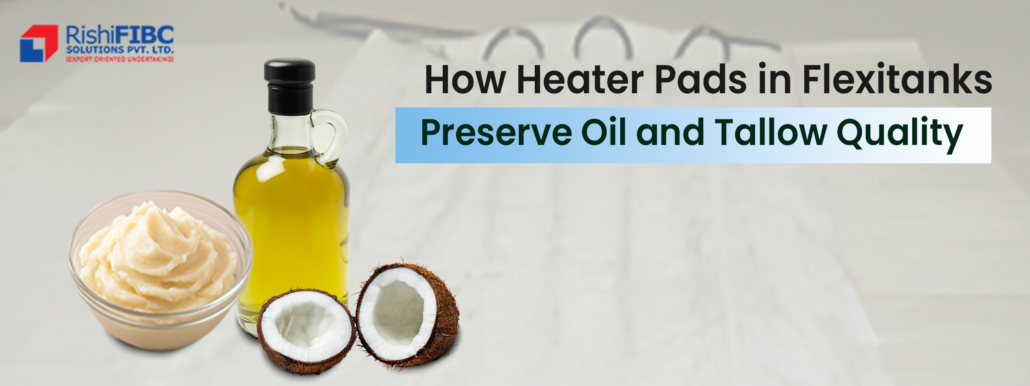When transporting temperature-sensitive liquids like tallow and coconut oil, the challenge lies in preserving their quality from origin to destination. These oils solidify at lower temperatures, causing delays during unloading and risking product quality degradation. The solution? A flexitank heating pad.
Designed to maintain the right viscosity, heating pads integrated into flexitanks ensure smooth flow and prevent crystallization or hardening. For shippers, exporters, and distributors, this means less product loss, faster discharge, and better quality assurance.
Heater Pads for Flexitanks: Solving Real Transport Challenges
Tallow and coconut oil are both highly susceptible to temperature fluctuations. When exposed to cold during transit, they tend to solidify, making discharge difficult and sometimes damaging the container lining. If not reheated correctly, it can lead to uneven temperatures and quality deterioration.
Heater pads for flexitanks directly address these concerns. By providing a consistent and controlled source of heat, they:
- Maintain the optimal temperature throughout the journey
- Help retain oil fluidity until final delivery
- Reduce energy consumption compared to external heating
- Eliminate the need for costly reprocessing due to solidification
This proactive approach protects both the cargo and the reputation of the supplier.
How Flexitank Heating Pads Work
Heater pads are usually placed at the bottom of the flexitank. When connected to steam or hot water sources upon arrival, they slowly warm the contents inside the tank. This allows the oils to return to their liquid state gently, preserving chemical integrity and taste (in case of edible oils like coconut).
Unlike external heating systems that may apply uneven or harsh heat, flexitank heating pads offer a more uniform and product-safe method. This avoids overheating or burning, especially important for edible oils and high-grade tallow.
Why Partnering With the Right Flexitank Manufacturer Matters
A well-designed flexitank is only as good as its components. That includes the quality of the heating pad. A trusted Flexitank Manufacturer ensures compatibility, durability, and global compliance.
Rishi’s Fluid Flexitank products come with integrated heating pad options that:
- Are easy to connect and use
- Support fast discharge at destination
- Reduce waste and cleaning costs
- Comply with international standards for food-grade products
When your shipment spans continents, you need reliability, and that starts with choosing a flexitank solution built for your product.
Flexitank Heating Pad in Action: Tallow and Coconut Oil
For tallow, which solidifies just below 25°C, heater pads prevent blockages during unloading, especially in colder ports. Similarly, coconut oil becomes semi-solid below room temperature. In both cases, delays in discharge often lead to penalties or product rejection.
A flexitank heating pad ensures that the temperature inside the tank remains within acceptable limits. This protects the cargo’s flowability and visual appearance and helps maintain purity.
By using heating pads, many exporters have reported:
- 30% faster unloading time
- 15% reduction in product loss due to residue
- Zero contamination or overheating incidents
It is a small addition with a big impact.
Make Every Drop Count – Choose Heating Pads for Flexitank
If you are shipping tallow, coconut oil, or any temperature-sensitive liquid, do not take chances with quality. Rely on trusted heater pad-equipped flexitank systems. Our team at Fluid Flexitanks ensures your cargo stays in optimal condition until the last drop.
Let us help you maintain quality, save cost, and simplify your bulk liquid logistics. Contact us today to explore our flexitank heating solutions.
FAQs
- What is a flexitank heating pad?
It is a heat-conducting pad placed under the flexitank to warm temperature-sensitive liquids like tallow and coconut oil during or after transit, making discharge easier and preserving quality. - Why do tallow and coconut oil need heater pads?
Both oils solidify in cooler temperatures, making discharge difficult. Heater pads gently reheat the oil, keeping it in liquid form without harming the product. - Are heater pads safe for food-grade products?
Yes, reputable flexitank manufacturers offer food-safe heating pads that comply with FDA and global standards, ensuring product integrity during shipment. - Can I reuse flexitanks with heater pads?
Most flexitanks, including those with heating pads, are designed for single-use to ensure hygiene and eliminate cleaning or cross-contamination risks.

